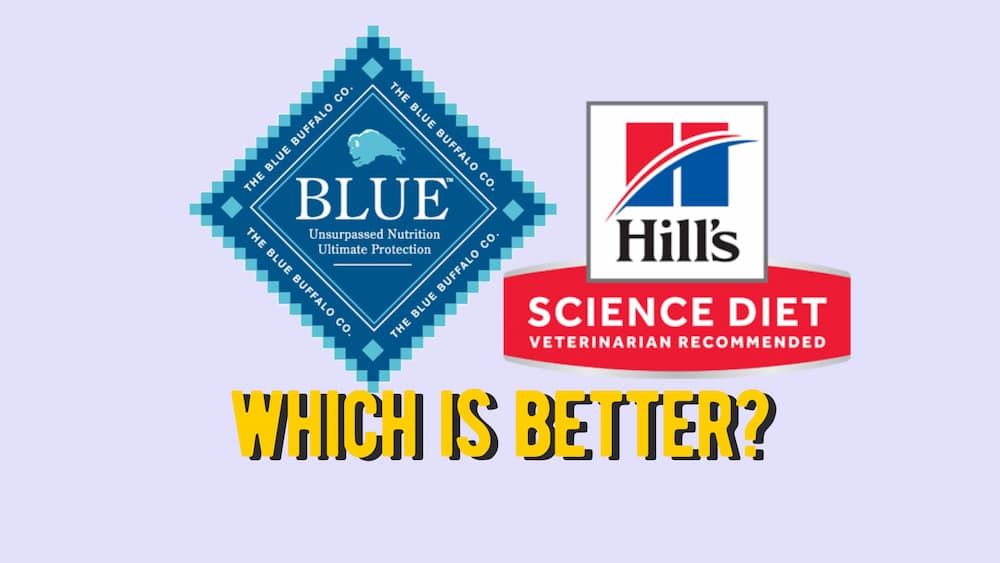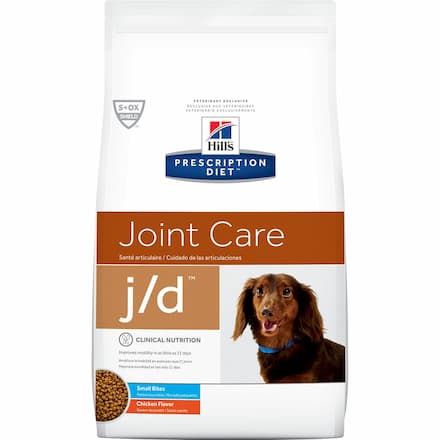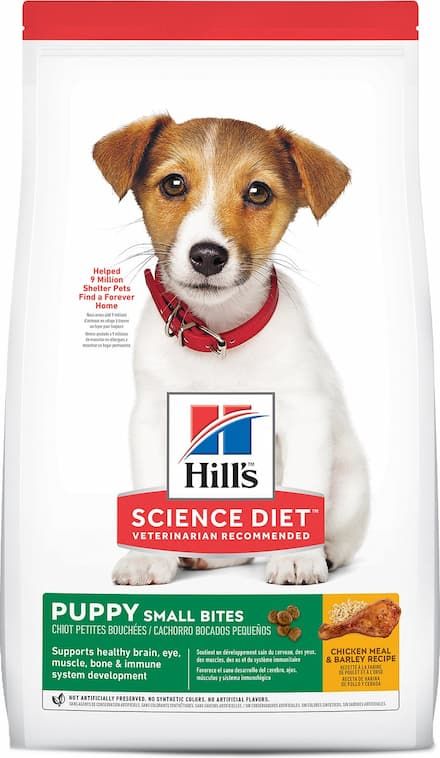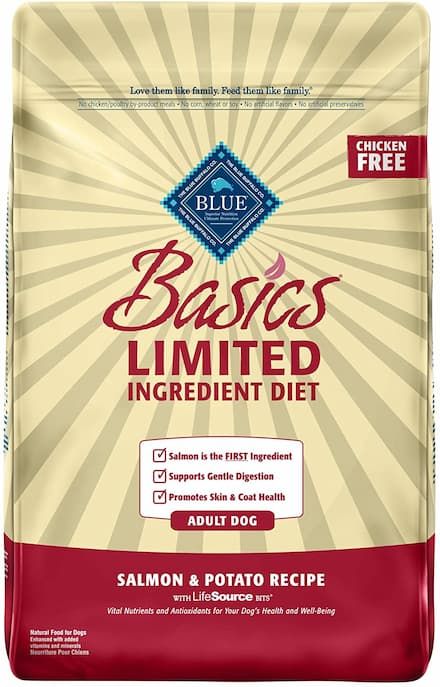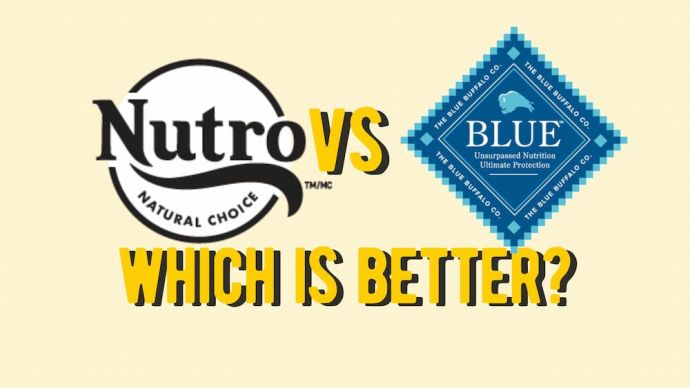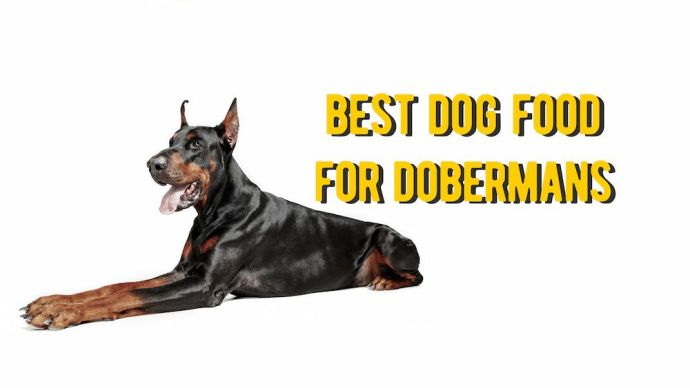Science Diet vs Blue Buffalo: Which Dog Food is Better?
Written by:
Author: Vicki Smirnova
Vicki Smirnova is a professional writer and editor who adores animals and helps readers get along well with their pets. She has been working in digital media for more than 5 years and has great experience writing content about lifestyle, including pets. Vicki specializes in dog health and nutrition, cat feeding, dog training. She is an aquarium lover and is passionate to write about fish care at home. Also, Vicki headed several websites and worked as a news editor.
View all 245 articlesLearn about our editorial process and veterinary review board.
Reviewed by:
Veterinary review
by Dr. Edele Grey
Dr. Edele Grey is a veterinary surgeon with seven years of experience. She professionally works mostly with horses but has treated pets of all sizes including terrapins, llamas, and others. Dr. Grey graduated with honors from the University College Dublin, Ireland, has completed further education in Equine Sports Medicine. In her free time, she enjoys writing about pet ownership and educating people about veterinary care of animals and preventing disease.
View all 10 articlesLearn about our veterinary review board
Viewed: 8381
Updated on: 08/30/2022
Your pet’s diet plays a significant role in the development and health of your pooch. This article will compare two popular manufacturers of dog food: Blue Buffalo vs. Hills Science Diet. When choosing the perfect food for your pet, you need to pay attention to the nutrient composition. We analyzed each ingredient in these brands, including minerals and vitamins. In addition, we’ve highlighted the best diets from each pet food brand to help you make an informed decision about your pet’s diet.
Blue Buffalo vs Hills Science Diet Dog Food Comparison
For comparison, we chose two of the most popular products from the Hills Science Diet and Blue Buffalo brands. In this table, we look at the nutrients in the composition of each feed, highlight the main protein and carbohydrates. We also provide our opinion based on the nutrient research, recommendations of a veterinarian, and customer reviews.
| Blue Buffalo | Hills Science Diet | |
| Our rating | 3 | 4 |
| Primary Protein Source/ Primary Carbohydrate Source | Chicken / Brown Rice | Chicken/ Whole Grain Wheat, Whole Grain Corn |
| First Five Ingredients Listed | Deboned Chicken, Chicken Meal, Brown Rice, Barley, Oatmeal | Chicken Meal, Cracked Pearled Barley, Pea Fiber, Whole Grain Wheat, Whole Grain Corn |
| Protein | 24.0% min | 20.0% min |
| Fat | 14.0% min | 5.5% min |
| Fiber | 5.0% max | 14.0% max |
| Moisture (max.) | 10.0% max | 10.5% max |
Both Science Diet and Blue Buffalo products have high consumer ratings and are considered good quality diets. The Hill’s Science Plan brand products are represented by a range of dog food in dry and wet versions. This brand has several production lines. For example, Science Plan recipes are designed for animals that don’t have pronounced health problems. They are freely sold in retail chains. Others, such as the Prescription diet plans, are suitable only for dogs with health problems. Each Hill’s Prescription Diet food is designed with the latest advances in nutritional science in mind. Hill’s prides itself on offering nutrition to take care of the health of pets with special needs.
To develop the products, the company hires scientists and veterinary specialists in the sphere of pet nutrition. Hill’s is constantly conducting clinical research to be at the fore of optimal pet nutrition. Therefore, these foods support pet health, taking care of the health of the digestive and urinary systems, oral care, food allergies, and other conditions. Hill’s Prescription Diet is a diet that requires the recommendations of a veterinarian. If your pet has been diagnosed with a specific medical condition, or you think it may need additional support, make an appointment with your veterinarian to learn more about how Hill’s Prescription Diet can help your pet feel good. Consult your veterinarian about dietary recommendations, especially if your pet’s existing diet may not be appropriate for your animal’s health condition.[1]
“As a veterinarian, I recommend Hill’s products because of the scientific investigation and thorough research that supports their product claims. These products are also guaranteed to be consistent with their ingredients which is essential for pets with health conditions or digestive issues.”
DVM Edele Grey
In turn, the manufacturer Blue Buffalo also offers various lines of dog food, which include formulae depending on age and size. Feeds are available for puppies, adult, and elderly pets and are divided between large, medium, and small breeds. The company nutrients a dog needs are water, protein, fat, carbohydrates. They are used in every diet to support all normal functions of the body. Each brand has a fairly wide range of recipes.
Assortment Blue Buffalo vs Hills Science Diet
| Product | Blue Buffalo | Hills Science Diet |
| Dry dog food | 85 recipes | 87 recipes |
| Wet dog food | 101 recipes | 99 recipes |
| Treats for dogs | 51 recipes | 45 recipes |
Hills Science Diet
Pros
Cons
- Rich experience and a long history.
- A wide range of diets.
- Diets suitable for specific health conditions.
- Controversial ingredients are used.
- Some products are only available by prescription.
- The nutritional information can be difficult to understand.
Blue Buffalo
Pros
Cons
- It does not use fillers and by-products.
- A good composition of vitamins and antioxidants.
- Created in collaboration with veterinarians and nutritionists.
- Customer satisfaction varies significantly.
- High price.
History
Let’s take a deeper dive into how these companies were founded and what missions and goals they pursue. A brand’s history is an important part of selecting the best pet food for your buddy.
Science Diet
Hills was created by veterinarian Dr. Mark Morris. After seeing the link between poor nutrition and pet diseases, Dr. Mark Morris developed a pet food that was superior to any other on the market. Soon, Dr. Morris met a blind man, Morris Frank and his beloved guide dog Buddy. Buddy was suffering from kidney disease. Dr. Morris knew that many commercial pet foods available at the time contained large amounts of phosphorus and protein to improve their taste, and that their consumption could damage the kidneys. So he set about developing special diet to support kidney function. This is how Hill’s Prescription Diet k/d was created, which became the first commercially available Hills pet food. This allowed Morris and Buddy to spend many more happy years together.
Dr. Morris’s son Dr. Mark Morris Jr. went on to help further develop Hill’s Pet Nutrition over the next few decades. In 1968, the Hill’s Science Diet line was provided by veterinarians and pet specialists. The line has continued to expand, and today it includes more than 50 pet foods designed for different ages and the unique needs of different pets.
Blue Buffalo
Blue Buffalo is a relatively new company that was founded in Wilton, Connecticut, in 2003. Jackie and Bill Bishop created the company after their beloved dog named Blue lost his battle with cancer. Together with a leading veterinarian and nutritionist, the family decided to develop a nutritious dog food that can be used for pets with health problems. The brand’s slogan, “Love them like family, feed them like family” is still at the company’s heart.
The food created by the Bishops was of such high quality that it quickly gained popularity with other dog owners. In less than twenty years, the brand has gone from founding to becoming a leading brand of natural pet food. In the production of these foods, natural ingredients are used, such as real meat. The founders believe that a healthy, balanced diet is the key to solving and alleviating serious health problems in pets. The company uses high-quality ingredients without animal by-products norcheap fillers.
Food Ingredients
A healthy, balanced diet is a fundamental component of your pet’s life. Nutritionally balanced foods are essential while excluding anything toxic to pets. Even though our canine companions are carnivorous, they also need plants within their diet.
The necessary nutrients for the normal functioning of the dog:
- Proteins
- Fats
- Carbohydrates
- Mineral substances
- Vitamins
- Water
The protein added to the feed can be of both animal and vegetable origin, animal protein tends to be considered higher quality since they are complete proteins (containing all amino acids required). The most commonly used animal proteins are beef, chicken, eggs, fish, and by-products such as organ meats and bone meal. Parts of slaughtered poultry containing bones, head, legs, and offal are used as poultry by-products. As a source of vegetable protein, the most commonly used are corn, soy, wheat and barley products. When it comes to the protein content in your pet’s diet, don’t just look at the percentage, but also its quality and, consequently, digestibility.
Carbohydrates can be either digestible or indigestible. The main sources of digestible carbohydrates in many pet foods are rice, wheat, oats, barley, carrots, flaxseed, peas, and potatoes.
Dietary fiber is essential for the normal functioning of the digestive tract. Fiber is an indigestible form of carbohyrdate and sources include grain brans (oat, barley or wheat), soy hulls and beet pulp.
Fats are included as both an energy source to food and also for flavor enhancement. Pet’s need essential fatty acids in their diets that they can’t produce themselves. These tend to be sourced from animal fats as they are readily absorbed.
Like all mammals, dogs require vitamins and minerals to maintain their long-term health. In addition, antioxidants and preservatives are also added to commercial diets to ensure product freshness and shelf-life. Antioxidants can be of both artificial and natural origin (e.g. vitamin E).[2]
Science Diet
The company claims that the optimal combination of nutrients is provided by high-quality ingredients, which are determined taking into account the research of the community of veterinary specialists. Hill’s combines nutrient-rich, high-quality ingredients in its products, making these balanced foods trusted by veterinarians and recommended for more than 60 years. Hill’s Science Diet commonly contains the following:
- Corn, rice, barley, sorghum — carbohydrates for energy and other nutrients for healthy skin and coat.
- Animal fat, fish oil and vegetable oil — fats and essential fatty acids for energyand healthy skin and coat.
- Chicken and turkey, lamb, and eggs are high-quality proteins for muscle development, and healthy skin.
- Cellulose, soy flour, and beet pulp are sources of fiber that promote intestinal health and satiety which is useful in weight control.
Controversial ingredients used by Hill’s Science Diet:
- Caramel
- Caramel Colour
Blue Buffalo
Blue Buffalo offers a wide range of dog food. The brand does not add artificial preservatives, fillers, or flavors to their foods. On their website, they state that their food does not contain wheat, soy, or corn.
The main ingredients of Blue Buffalo dog food include rabbit, chicken, beef, lamb, turkey, salmon, duck, trout, and oatmeal. Most formulas also add various vegetables, fruits, probiotics, and dried tomato cakes. Each of their formulas is enriched with added vitamins. They also include recognizable fats, such as chicken fat. It is an excellent source of fatty acids.
Unlike other companies, Blue Buffalo does not use ambiguous language when describing the ingredients in its products.
Controversial ingredients used by Blue Buffalo:
- Garlic
- Caramel
- Caramel Color
As you can see, both of these companies provide suitable nutrient profiles for pets to meet their requirements.
Guaranteed Analysis
According to the AAFCO (Association of American Feed Control Officials) , each pet food package must have labels with a guaranteed analysis of the nutrient content. In each recipe, the minimum content of raw protein and raw fat should be noted, as well as the maximum content of raw fiber and moisture.
Here, we compare the most important nutrients that our pets need.
Protein is important in a balanced dog diet, as it is an integral part of building and repairing muscles and other body tissues. It helps to form new skin cells, grow hair, build muscle, and helps in the creation of hormones and enzymes needed for daily life. Protein deficiency can lead to health problems such as skin diseases, hormonal imbalances, growth retardation, and even behavioral changes. The minimum protein intake for an adult dog is approximately 18%.
Dogs require an appropriate fat composition as part of a balanced diet. Fat provides energy, taste, aroma, and most importantly, promote the absorption of certain vitamins. Common fats used in dog food include chicken or pork fat, fish oil, and sunflower oil, . The average adult dog needs a minimum of 5% fat in their diet to stay healthy.
Dietary fiber is mainly the carbohydrate residues of plant cells after digestion. There’s no minimum requirement for the fiber content of dog foods. Soluble fiber absorbs water from outside the colon into the dog’s bowel movements and thus helps prevent constipation by promoting regular bowel movements. Fiber is the “stabilizer” of the stool. Fiber is also great for dogs who need to lose weight, by reducing the calorie content of their food while promoting the feeling of “fullness”. [3]
Science Diet (average)
| Science Diet | Dry Dog Food | Wet/Canned Dog Food |
| Crude Protein | 24.5% | 25.8% |
| Crude Fat | 14.8% | 17.1% |
| Crude Fiber | 4.3% | 3.3% |
Blue Buffalo (average)
| Science Diet | Dry Dog Food | Wet/Canned Dog Food |
| Crude Protein | 28.5% | 40.3% |
| Crude Fat | 15.0% | 25.0% |
| Crude Fiber | 7.1% | 7.6% |
The table shows that Hill’s Science Diet provides less protein than Blue Buffalo. The difference in protein content is roughly 5-6%. In addition, Blue Buffalo wet dog foods also provide more protein than Hill’s Science Diet wet foods (40% vs 25%). Like protein, fats are an essential part of a dog’s body. Fats are needed for the normal physiological functions within the canine body. Hill’s Science Diet and Blue Buffalo guarantee a similar amount of crude fat in their dry foods. For wet dog foods, Blue Buffalo provides significantly more fat (about 8.67% more). Blue Buffalo also typically guarantees 2.60% more fiber.
History of Recalls
Companies can recall their products for certain reasons related to the safety of pets.
Science Diet
This brand has recorded only three recalls of dog food. This is an excellent indicator, given the length of the company’s existence.
2014: Science Diet recalled 62 bags of dry food because they could potentially contain salmonella. In the same year, the company recalled a batch of canned dog food due to potentially elevated vitamin D levels.
2019 is another product recall due to more vitamin D concerns.
Blue Buffalo
Blue Buffalo has recalled its products 9 times. Using the website of the FDA and the American Veterinary Medical Association (AVMA), we found out the reasons and compiled a timeline:
2007: The rice protein from the manufacturer they used was contaminated with melamine. After the investigation, Blue Buffalo announced that it would stop trading with the accused manufacturers.
2010:The company recalled some products because they were found to potentially contain higher levels of vitamin D than were safe.
2014: Purina filed a lawsuit against Blue Buffalo for false advertising. They found ingredients for poultry by-products in their recipes, even though Blue Buffalo stated that it never uses by-products.
2015: Potential salmonella infection. No illnesses were reported.
2016: Product recall due to high humidity inside the packaging, which then led to the formation of mold.
2017: Possible aluminum contamination. No illnesses were reported.
Prices Comparison
The table below presents the average price data between both companies.
Science Diet
| Science Diet | Dry Dog Food | Wet Dog Food |
| Per Pound | $2.18 | $3.51 |
| Per Calorie | $0.0014 | $0.0086 |
Blue Buffalo
| Science Diet | Dry Dog Food | Wet Dog Food |
| Per Pound | $2.75 | $4.30 |
| Per Calorie | $0.0017 | $0.0086 |
Most Popular Dog Food Formulas Comparison
Here we have compared some popular diets from both manufacturers and analyzed the pros and cons of each diet. Remember that each dog is individual and you need to choose a diet that best suits your pet. Your veterinarian is the best person to ask for specific advice.
TOP Dog Foods of Hill’s Science Diet
Hill’s Prescription Diet j/d Joint Care
This food reduces painful inflammation in the joints and slows the progression of arthritis through the inclusion of joint health supporting ingredients.
The eicosapentaenoic acid (EPA) content reduces the degradation of articular cartilage, confirming Hill’s innovation in the use of fatty acids. EPA is an essential fatty acid. The new packaging technology (New Fresh Pack System) ensures a stable level of fatty acids and preserves the freshness of dry food.
Key features:
- Helps maintain a healthy weight and avoid extra stress on joints.
- Supports a healthy immune system.
- An excellent source of the Omega 3 fatty acid.
Pros
Cons
- Helps preserve joint cartilage.
- Contains EPA, to nourish cartilage.
- Improving your dog’s mobility.
- This needs authorization from your veterinarian.
Hill’s Science Diet Puppy Healthy Development Small Bites Dry Dog Food
Specially developed for puppies, Hill’s food meets all the needs of puppies during the development period to grow up strong and healthy. Specially formed in smaller kibbles for puppy mouths. This food contains a special blend of antioxidants to support the immune system throughout life with a balanced mineral content to strengthen bones and teeth.
For detailed recommendations on feeding, see the packaging. If necessary, change the serving size to maintain the optimal weight of yourpup. If in doubt, consult your veterinarian.
Key features:
- Contains natural DHA (Docosahexaenoic acid) from fish oil.
- It helps support a healthy immune system.
- Smaller kibble size.
Pros
Cons
- Easy-to-digest.
- Antioxidant and vitamin E and C blend.
- Made in the USA.
- None
TOP Dog Foods of Blue Buffalo
Blue Buffalo Blue Basics Adult Salmon & Potato
Blue Basics Salmon & Potato Recipe Dog Food is a limited-ingredient diet designed to support pets with food sensitivies.
Some dogs experience digestive problems. This food contains high-quality protein, and potatoes. Blue Buffalo contains added glucosamine and chondroitin for joint and hip health and taurine for heart health.
Key features:
- Single animal protein source – deboned salmon.
- Support digestion.
- NO corn, wheat, soy, dairy or eggs.
Pros
Cons
- Easily-digestible carbohydrates.
- NO chicken (or poultry) by-product meals.
- Only natural ingredients.
- High in salt.
Blue Buffalo Natural Veterinary Diet GI Gastrointestinal Support
Blue Buffalo Natural Veterinary Diet GI Gastrointestinal Support dog Food is made from easily digestible ingredients. All protein, carbohydrate, and fat in thisdiet contribute to the optimal maintenance of your pet’s digestive health. This veterinary diet contains prebiotic fiber, which supports the healthy microflora of your pet’s digestive tract.
The formula contains vitamins E and C and antioxidant-rich ingredients, including blueberries and cranberries, which help support a healthy immune system. This recipe is designed to meet the nutritional needs of dogs at all stages of life.
Key features:
- Contains vitamins E, C, and antioxidant-rich ingredients.
- Gastrointestinal support.
- Help balance and support your pal’s healthy microflora.
Pros
Cons
- Only natural ingredients.
- Formula made with prebiotic fibers.
- Support a healthy immune system.
- This needs authorization from your veterinarian.
READ MORE: How Long Does it Take a Dog to Digest Food?
Final Word
Following a comparison of these two popular manufacturers, both companies are trustworthy. Food choice depends on whether you prefer an all-natural diet or a diet enriched with artificial ingredients that are beneficial for dogs.
If you’re not a fan of grain-free food, Science Diet offers a great choice of diets for everyone for all life stages and animal sizes. If you prefer an all-natural brand, with a wide variety of grain-free formulas, then Blue Buffalo is more suitable for you. This comparison guide comes down to personal preferences, but now you know everything you need to know to make an informed decision!
FAQ
Is Science Diet better than Blue Buffalo?
It is impossible to say exactly which manufacturer is better. You should choose the food depending on the preferences of your pet and the recommendation from your veterinarian.
Why do vets recommend Science Diet?
Veterinarians around the world recommend and feed their own pets with Hill’s products. The organization has a fully equipped veterinary clinic, certified by the American Association of Veterinary Clinics (AAHA), which meets the high standards of veterinary clinics.
What dog food is better than Blue Buffalo?
One of the main competitors of the company Blue Buffalo within the field of ‘all natural diets’ is Taste of the Wild. The food from this manufacturer tends to be cheaper, but they claim their formulations use the best ingredients.
Is Science Diet a good dog food?
In short, yes! These diets are scientifically proven to support your pet’s health. The diets of this brand meet the AAFCO nutrition standards. This food comes in a wide range of formulas. There are different diets for different breeds, sizes, and ages of dogs. Veterinarians recommend Science Diet.
READ MORE: When to Switch to Senior Dog Food?
Article Sources:
- “Body and Muscle Condition Score.” American Animal Hospital Association, aaha.org/aaha-guidelines/life-stage-canine-2019/nutritional-assessment/body-and-muscle-condition-score/.
- “Antioxidants and Their Use in Dog Food.” Pet MD, petmd.com/dog/nutrition/evr_dg_antioxidants_and_their_use_in_dog_food.
- “Nutrition – General Feeding Guidelines for Dogs.” VCA Animal Hospital, vcahospitals.com/know-your-pet/nutrition-general-feeding-guidelines-for-dogs.
 Dog Food Reviews The 10 Best Dog Food For a Sensitive Stomach (Vet Approved Review)
Dog Food Reviews The 10 Best Dog Food For a Sensitive Stomach (Vet Approved Review) - 595
- 0
 Dog Products & Toys Reviews The 10 Best Brush for Australian Shepherd: Review and Buying Guide
Dog Products & Toys Reviews The 10 Best Brush for Australian Shepherd: Review and Buying Guide - 12902
- 0









